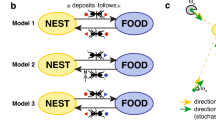Abstract
In this study, we synthesize a novel dynamical approach for ant colonies enabling them to migrate to new nest sites in a self-organizing fashion. In other words, we realize ant colony migration as a self-organizing phenotype-level collective behavior. For this purpose, we first segment the edges of the graph of ants’ pathways. Then, each segment, attributed to its own pheromone profile, may host an ant. So, multiple ants may occupy an edge at the same time. Thanks to this segment-wise edge formulation, ants have more selection options in the course of their pathway determination, thereby increasing the diversity of their colony’s emergent behaviors. In light of the continuous pheromone dynamics of segments, each edge owns a spatio-temporal piece-wise continuous pheromone profile in which both deposit and evaporation processes are unified. The passive dynamics of the proposed migration mechanism is sufficiently rich so that an ant colony can migrate to the vicinity of a new nest site in a self-organizing manner without any external supervision. In particular, we perform extensive simulations to test our migration dynamics applied to a colony including 500 ants traversing a pathway graph comprising 200 nodes and 4000 edges which are segmented based on various resolutions. The obtained results exhibit the effectiveness of our strategy.









Similar content being viewed by others
References
Abbasy A, Hosseini SH (2007) Ant colony optimization-based approach to optimal reactive power dispatch: a comparison of various ant systems. In: 2007 IEEE power engineering society conference and exposition in Africa-PowerAfrica. IEEE, pp 1–8
Al-Shihabi ST, AlDurgam MM (2017) A max-min ant system for the finance-based scheduling problem. Comput Ind Eng 110:264–276
Ashraf A, Porres I (2018) Multi-objective dynamic virtual machine consolidation in the cloud using ant colony system. Int J Parallel Emergent Distrib Syst 33(1):103–120
Biswas PK, Phoha S (2006) Self-organizing sensor networks for integrated target surveillance. IEEE Trans Comput 55(8):1033–1047
Camazine S, Deneubourg J-L, Franks NR, Sneyd J, Theraula G, Bonabeau E (2020) Self-organization in biological systems. Princeton University Press, Princeton
Deng W, Xu J, Zhao H (2019) An improved ant colony optimization algorithm based on hybrid strategies for scheduling problem. IEEE Access 7:20281–20292
Deng W, Xu J, Song Y, Zhao H (2020) An effective improved co-evolution ant colony optimisation algorithm with multi-strategies and its application. Int J Bio-Inspir Comput 16(3):158–170
Dorigo M, Gambardella LM (1997) Ant colony system: a cooperative learning approach to the traveling salesman problem. IEEE Trans Evolut Comput 1(1):53–66
Hagberg A, Swart P, Chult DS (2008) Exploring network structure, dynamics, and function using NetworkX. In: Los Alamos National Lab.(LANL), Los Alamos, NM (United States), Tech. Rep
Karaboga D (2010) Artificial bee colony algorithm. Scholarpedia 5(3):6915
Kydonieus AF (2019) Insect suppression with controlled release pheromone systems: volume I. CRC Press, Boca Raton
Leclerc J-B, Pinto Silva J, Detrain C (2018) Impact of soil contamination on the growth and shape of ant nests. R Soc Open Sci 5(7):180267
Li G, Boukhatem L (2013) Adaptive vehicular routing protocol based on ant colony optimization. In: Proceeding of the tenth ACM international workshop on vehicular inter-networking, systems, and applications, pp 95–98
Macktoobian M, Aliyari Sh M (2017) Optimal distributed interconnectivity of multi-robot systems by spatially-constrained clustering. Adapt Behav 25(2):96–113
Macktoobian M, Duc GF (2022) Meta navigation functions: adaptive associations for coordination of multi-agent systems. In: American control conference (ACC). IEEE, pp 1921–1926
Meng X-B, Gao XZ, Lu L, Liu Y, Zhang H (2016) A new bio-inspired optimisation algorithm: bird swarm algorithm. J Exp Theor Artif Intell 28(4):673–687
O’Shea-Wheller TA, Sendova-Franks AB, Franks NR (2016) Migration control: a distance compensation strategy in ants. Sci Nat 103(7):1–9
Pitcher T (2001) Fish schooling. In: Encyclopedia of ocean sciences: marine biology, pp 337–349
Skaldina O, Peräniemi S, Sorvari J (2018) Ants and their nests as indicators for industrial heavy metal contamination. Environ Pollut 240:574–581
Türk S, Radeke R, Lehnert R (2010) Network migration using ant colony optimization. In: 2010 9th conference of telecommunication, media and internet. IEEE, pp 1–6
Wang Y, Geng C, Xu N (2021) Assembly sequence optimization based on hybrid symbiotic organisms search and ant colony optimization. Soft Comput 25(2):1447–1464
Author information
Authors and Affiliations
Corresponding author
Additional information
Publisher's Note
Springer Nature remains neutral with regard to jurisdictional claims in published maps and institutional affiliations.
Rights and permissions
About this article
Cite this article
Macktoobian, M. Self-organizing nest migration dynamics synthesis for ant colony systems. Nat Comput (2022). https://doi.org/10.1007/s11047-022-09923-0
Accepted:
Published:
DOI: https://doi.org/10.1007/s11047-022-09923-0




